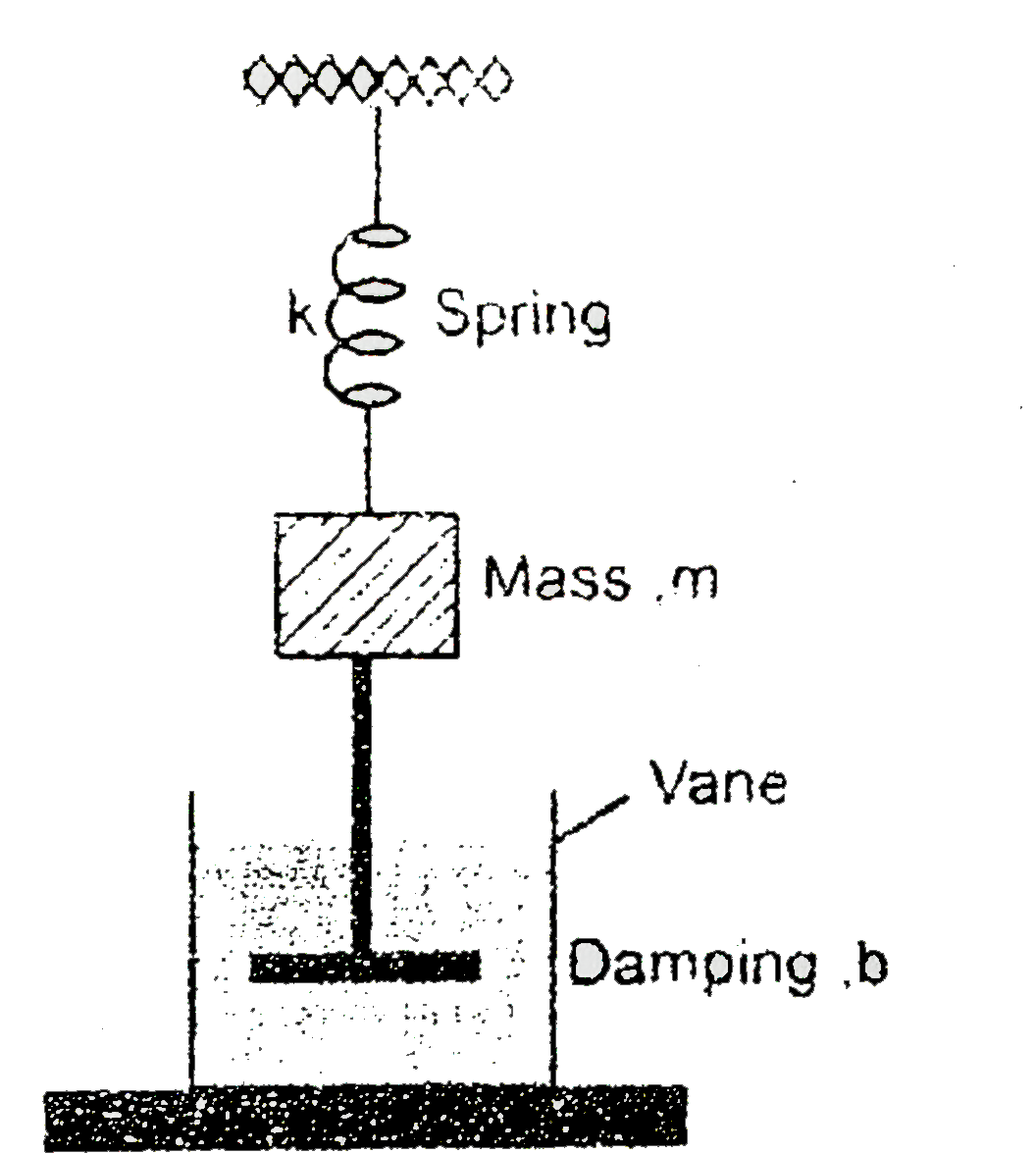In a damped oscillatory motion a block of mass 200 g is suspended to a spring of force constant 90 N/m in a medium and damping constant is 40 g/s. Find (a) time period of oscillation (b) time taken for its amplitude of oscillation to drop to half to its initial value (c) time taken for its mechanical energy to drop to half of its initial value.
Mass m = 200 g = 0.2 kg force constant k = 90 N/m
damping constant b= 40 g/s = 0.04 kg/s
√km=√90×0.2=√18kg/s
Here b<<√km
a) time period T=2π√mk=2π√0.290=0.3s
b) amplitude =Ae−bt/2m
Let amplitude is dropped to half of its initial value after the time T1/2 . Amplitude A.e−b.T1/22m=A2
e−b(T1/2)2m=In(12)
⇒T1/2=In(2)b/2m=2.302×0.3010×2m/b
T1/2=0.693×2mb=0.693×2×0.20.04=6.93s
c) Let the energy is dropped to half of its initial value after a time t1/2
Initial energy E0=12KA2
At time t1/2, energy =12E0=12kA2e−b.t1/2m=12(12kA2)
e−b.t1/2m=12⇒t1/2=ln(2)×mb=0.693×mb
t1/2=0.693×0.20.04=3.46s
Topper's Solved these Questions
- OSCILLATIONBOOK - AAKASH SERIESCHAPTER - OSCILLATIONEXERCISE - VERY SHORT ANSWER TYPE QUESTIONS
31 Videos
- OSCILLATIONBOOK - AAKASH SERIESCHAPTER - OSCILLATIONEXERCISE - NUMERICAL EXERCISE (LEVEL-1)
33 Videos
- NEWTONS LAWS OF MOTION BOOK - AAKASH SERIESCHAPTER - NEWTONS LAWS OF MOTION EXERCISE - ADDITIONAL PRACTICE EXERCISE PRACTICE SHEET (ADVANECED) (Matrix Matching Type Questions)
1 Videos
- OSCILLATIONSBOOK - AAKASH SERIESCHAPTER - OSCILLATIONSEXERCISE - PRACTICE EXERCISE - SPRINGS
16 Videos
Similar Questions
In damped oscillatory motion a block of mass 20kg is suspended to a spring of force constant 90N/m in a medium and damping constant is 40g/s. Find (a) time period of oscillation (b) time taken for amplitude of oscillation to drop to half of its intial value (c) time taken for its mechanical energy to drop to half of its initial value.
View SolutionFor the damped oscillator shown in previous Figure, the mass m of the block is 400 g, k=45Nm−1 and the damping constant b is 80gs−1. Calculate .
(a) The period of osciallation ,
(b) Time taken for its amplitude of vibrations to drop to half of its initial value and
(c ) The time taken for its mechanical energy to drop to half its initial value.
View Solution
Knowledge Check
In the question number 93, the time elapsed for its mechanical energy to drop half of its initial value is
A2.5 sB3.5 sC4.5 sD7.5 sIn the question number 93, the time elapsed for its mechanical energy to drop half of its initial value is
A2.5 sB3.5 sC4.5 sD7.5 sFor the small damping oscillator, the mass of the block is 500 g and value of spring constant is k = 50 N/m and damping constant is 10 g s^(-1) The time period of oscillation is (approx.)
A2πsB2π13sCπ5sDπ√5s
For the damped oscillator shown in Figure, the mass m of the block is 400 g, k=45Nm−1 and the damping constant b is 80gs−1. Calculate .
(a) The period of osciallation ,
(b) Time taken for its amplitude of vibrations to drop to half of its initial value and
(c ) The time taken for its mechanical energy to drop to half its initial value.
View SolutionFor the damped oscillator shown in Fig, the mass of the block is 200g,k=80Nm−1 and the damping constant b is 40gs−1 Calculate
(a) The period of oscillation
(b) Time taken for its amplitude of vibrations to drop to half of its initial values
(c) The time for the mechanical energy to drop to half initial values

View SolutionFor the small damping oscillator, the mass of the block is 500 g and value of spring constant is k = 50 N/m and damping constant is 10gs^(-1) The time period of oscillation is (approx.)
View SolutionA block of mass 200 g executing SHM under the influence of a spring of spring constant k=90Nm−1 and a damping constant b=40gs−1. The time elapsed for its amplitude to drop to half of its initial value is (Given, ln (1/2)=−0.693)
View SolutionA block off mass 200 g executing SHM under the unfluence of a spring of spring constant k=90Nm−1 and a damping constant gb=40gs−1. The time elaspsed for its amplitude to drop to halff of its initial value is (Given, ln (1/2)=−0.693)
View Solution
